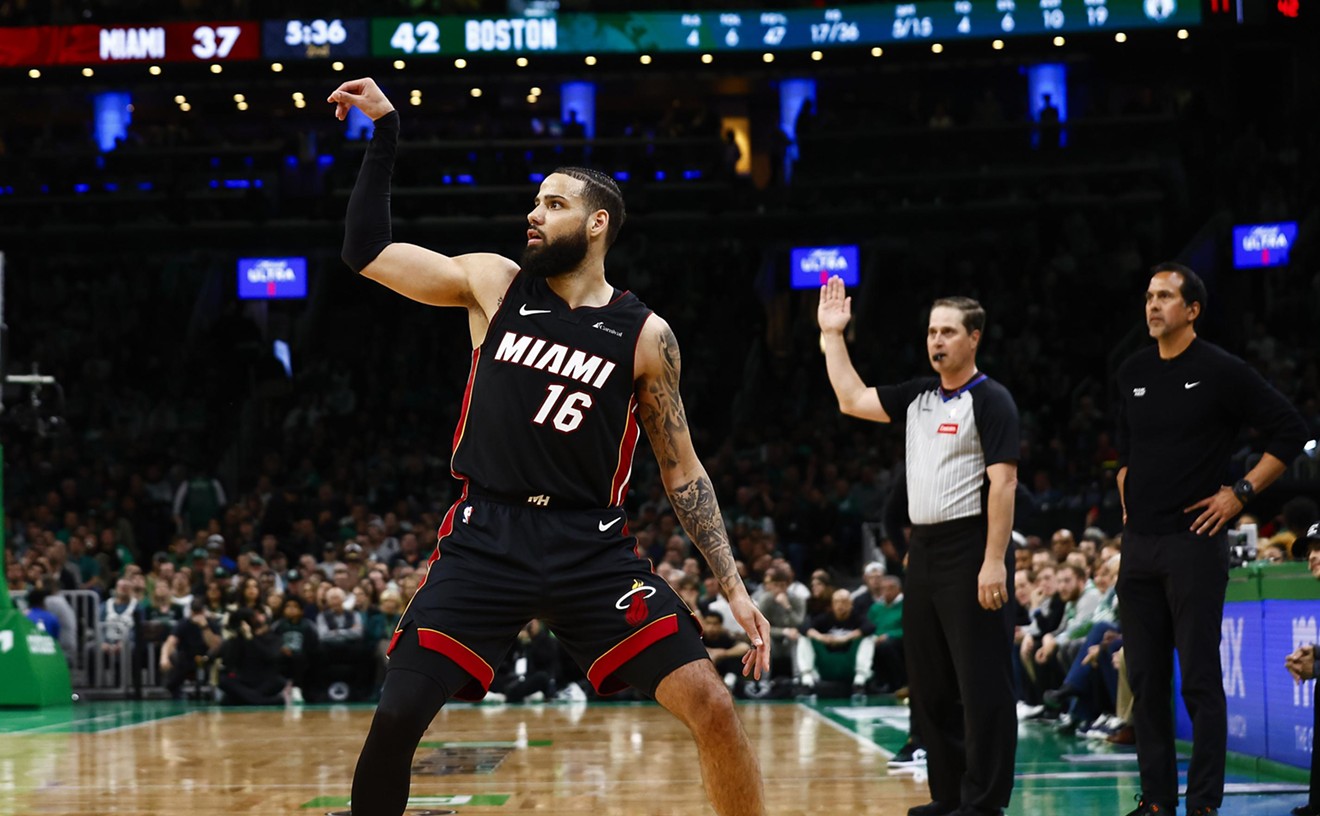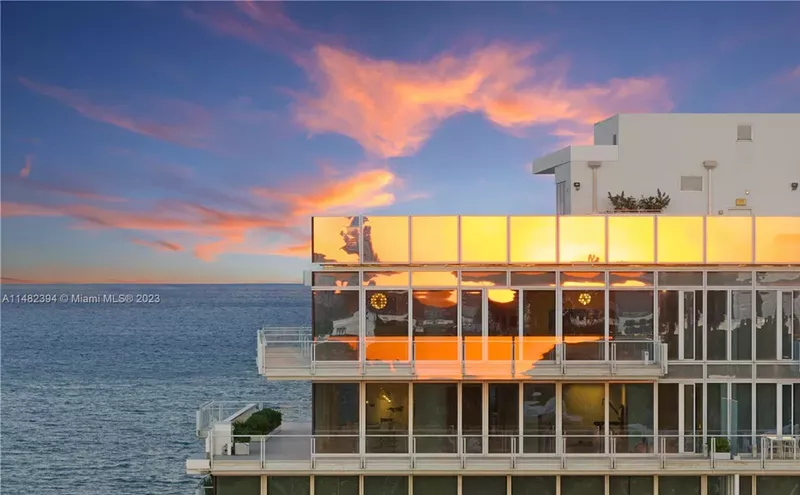Both are now gone.
Many Miamians can picture the Miami Stadium — rechristened Bobby Maduro Stadium in 1987 — as a decrepit hulk on NW Tenth Street and 23rd Avenue in Allapattah. Completed in 1949, it was home of Baltimore Orioles spring training for 31 years. Its dilapidated remains spent the first year-and-a-half of the 21st Century condemned behind a chainlink fence that did little to keep out the homeless and drug-addicted who were its final occupants. In 2001 it was demolished.
Jose Aleman Jr. was seventeen years old in 1949 when he received Miami Stadium as a gift from his dying father. Most Miamians won't remember his life at all, though they might recall his death. On July 31, 1983, Aleman found a Brown 9mm semiautomatic handgun in the Coral Springs apartment he shared with his mother. After threatening her with the weapon, he shot and injured three relatives. He killed his 69-year-old aunt, whom he told Miami-Dade SWAT teams he was holding hostage. He then shot himself.
Rolando Llanes was fascinated by these parallel endings. A native of Havana, a successful architect turned documentarian, and a lover of baseball, Llanes is also a rare Miami preservationist. He spent his childhood in New York City surrounded by historic structures. When he moved to Miami in 1973, at the age of twelve, he encountered an ephemeral landscape, where big and important buildings are often knocked down and forgotten with little ceremony, sometimes erasing the memory of those who inhabited them.
Llanes certainly knew none of Miami Stadium's history in the mid-Nineties, when the then-University of Miami architecture professor first visited the site. He was merely interested in seeing its cantilevered roof.
Fond of the facility's swooping aesthetic beauty, and with its doom impending, he organized a workshop for his students to devise ways to reposition the Miami Stadium as a community center or a mixed-use development. That's when he started investigating its history. Soon a passing interest in the locale — and the decline of its owner — became a passion.
In those pre-Google days Llanes pored through microfilm of old newspapers at the public library and consulted with local historians. A local filmmaker named John Graham learned of Llanes's research and proposed that they begin work on a documentary. Graham, who is originally from Michigan, worked in the local production industry and was searching for a film subject. "Everybody down here has done a movie about the Everglades," he says.
The dual story of Aleman and Miami Stadium was something different. Aleman was born in Cuba in 1932. His family relocated to Miami in 1948 after it was revealed that his father had been sponsoring an army of 1200 soldiers to take over the Dominican Republic. (One of the soldiers happened to be Fidel Castro.)
Jose Aleman Sr. paid for the stadium with money stolen from the Cuban treasury in the Forties, Llanes says. In late 1949, just as it was completed, he gifted it to his baseball-crazy teenage son shortly before he died of leukemia. "The story of Aleman could be independent of the stadium," says Llanes, explaining that his ownership lasted only eight years. "But we see it as very important that he inherited it as a kid. Inadvertently it became a problem for him that indicated what was to come."
Llanes refers to Aleman Jr.'s funding of the Cuban revolution — in 1957 he bankrolled the attack on the presidential palace in Cuba that nearly did in then-President Fulgencio Batista. But the cause left him broke and disillusioned when Castro confiscated his family's assets in Cuba.
In his final years Aleman also became increasingly paranoid about being whacked by the mob. In 1978 he testified before the U.S. House Select Committee on Assassinations about Santo Traficante Jr. He said the mafioso had hinted to him that John F. Kennedy Jr. would be killed. Aleman was also a one-time FBI informant.
Graham and Llanes learned the complexity of this story as they recorded interviews with associates of Aleman and baseball aficionados before the park's demolition. Their plans at the time were unclear; they just thought the place was worth saving. "It was a microcosm of what ballparks used to be," Llanes said, citing the lack of VIP arrangements. "Now the CEOs are all up in their suites."
Had it been saved, the stadium might have provided a home for the Florida Marlins. "They wouldn't have been able to do an upper deck and there would be too many seats in the outfield, but they could have fit maybe 20,000 seats," he said. "The Marlins don't attract that many fans right now."
Unfortunately the City of Miami, which had owned the stadium since purchasing it from Aleman in 1958, watched it decay until there was little left to salvage. (After their annual discussion, state legislators again went home this year without funding a new stadium for the Marlins. The issue might resurface in the special legislative session scheduled for June.)
In 2000, citing a fiscal crisis, the city unloaded the property to affordable housing developers, who knocked it down within a year. Llanes and Graham sadly attended the demolition in 2001, recording it on camera. It is still called the Bobby Maduro Stadium. Or rather, the Bobby Maduro Stadium Apartments.
"The developers wanted tax credits for the stadium's historic value, but they were just going to knock it down. They told the city commission they would build a museum," said Llanes, with bitterness. No museum is in evidence today.
Llanes put his footage in a box. He estimated he had amassed hundreds of hours. Then, late last year, he met Joe Cardona, owner of local documentary production company Kids in Exile Films. The history of Miami Stadium and Jose Aleman resonated with Cardona and his coworkers, who have produced numerous films about the Cuban exile experience. Joining forces with Llanes, they began interviewing more people, such as a pair of elderly barbers in Overtown who recalled attending games during segregation. The story of the Miami stadium, they realized, went far beyond the Cuban-American experience.
"It's a complete Miami story," Llanes said. "You rarely get that."
Thus encouraged, he bankrolled the documentary through donations from friends and family. White Elephant will premiere at Little Havana's Tower Theater on May 12. He hopes the movie will be viewed as more than mere historic documentation. There are plenty of structures around Miami facing the same fate as the Bobby Maduro Stadium.
Some, like the Hialeah Racetrack, are privately owned. Others, like Miami Marine Stadium and the Orange Bowl, are in the hands of the City of Miami and are slowly falling apart. In one hopeful case, megadeveloper Pedro Martin recently donated the Freedom Tower — former home of the Miami News and the emotional equivalent of Ellis Island for many Cuban-Americans who were processed there — to Miami Dade College. The college has pledged to rehabilitate it into a museum with classroom space.
But for Llanes a question remains: "What happens to these places that are wonderful, beautiful places that have no relevance?" For him, structures are inextricably linked to the stories of those who inhabited them. When you lose one, you often lose the other.
For more on the history of Bobby Maduro Stadium, see "Rough Diamond," by Robert Andrew Powell on Miaminewtimes.com.










